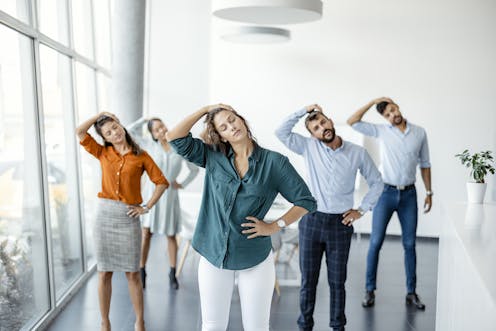The wellbeing ‘pandemic’ – how the global drive for wellness might be making us sick
- Written by Steven James Jackson, Professor and Co-Director, New Zealand Centre for Sport Policy & Politics, University of Otago

Are we in the midst of a wellbeing pandemic? The question may seem curious, even contradictory. But look around, the concept is everywhere and spreading: in the media, in government institutions and transnational organisations, in schools, in workplaces and in the marketplace.
To be clear, it’s not just wellbeing’s infectiousness in public discourse that makes it pandemic-like. It’s also the genuine malaise that can be caused by the term’s misuse and exploitation.
Do you sense, for example, that your wellbeing is increasingly being scrutinised by peers, managers and insurance companies? Are you noticing an increasing number of advertisements offering products and services that promise enhanced wellbeing through consumption? If so, you’re not alone.
But we also need to ask whether this obsession with wellbeing is having the opposite to the desired effect. To understand why, it’s important to look at the origins, politics and complexities of wellbeing, including its strategic deployment in the process of what we call “wellbeing washing[1]”.
The halo effect
While concerns about wellbeing can be traced to antiquity, the term has emerged as a central feature of contemporary social life. One explanation is that it is often conflated with concepts as diverse as happiness, quality of life, life satisfaction, human flourishing, mindfulness and “wellness”.
Wellbeing is flexible, in the sense that it can be easily inserted into a diverse range of contexts. But it’s also surrounded by a kind of halo, automatically bestowed with a positive meaning, similar to concepts such as motherhood, democracy, freedom and liberty.
To contest the value and importance of such things is to risk being labelled a troublemaker, a non-believer, unpatriotic or worse.
Read more: Wellbeing needs a rethink – and a global outlook is the way to start[2]
These days, there are two main concepts of wellbeing. The first – subjective wellbeing – emphasises a holistic measure[3] of an individual’s mental, physical and spiritual health. This perspective is perhaps best reflected in the World Health Organization’s WHO-5 Index[4], designed in 1998 to measure people’s subjective wellbeing according to five states: cheerfulness, calmness, vigour, restfulness and fulfilment.
Translated into more than 30 languages, the overall influence of the WHO-5 Index should not be underestimated; both governments and corporations have embraced it and implemented policy based on it.
But the validity of the index, and others like it, has been questioned. They’re prone to oversimplification and a tendency to marginalise alternative perspectives, including Indigenous approaches to physical and mental health.
Individual responsibility
The second perspective – objective wellbeing – was a response to rising social inequality. It focuses on offering an alternative to GDP[5] as a measure of overall national prosperity.
One example of this is New Zealand’s Living Standards Framework[6], which is guided by four operating principles: distribution, resilience, productivity and sustainability. These new and purportedly more progressive measures of national economic and social outcomes signal societal change, optimism and hope.
The trouble with such initiatives, however, is that they remain rooted within a particular neoliberal paradigm in which individual behaviour is the linchpin for change, rather than the wider political and economic structures around us.
Read more: Beyond GDP: changing how we measure progress is key to tackling a world in crisis – three leading experts[7]
Arguably, this translates into more monitoring and “disciplining” of personal actions and activities. Intentionally or not, many organisations interpret and use wellbeing principles and policies to reinforce existing structures and hierarchies.
Consider how the wellbeing agenda is playing out in your organisation or workplace, for example. Chances are you have seen the growth of new departments, work units or committees, policies and programs, wellness workshops – all supposedly linked to health and wellbeing.
You may even have noticed the creation of new roles: wellbeing coaches, teams or “champions”. If not, then “lurk with intent” and be on the lookout for the emergence of yoga and meditation offerings, nature walks and a range of other “funtivities” to support your wellbeing.
Wellbeing washing
The danger is that such initiatives now constitute another semi-obligatory work task, to the extent that non-participation could lead to stigmatisation. This only adds to stress and, indeed, unwellness.
Deployed poorly or cynically, such schemes represent aspects of “wellbeing washing”. It’s a strategic attempt to use language, imagery, policies and practices as part of an organisation’s “culture” to connote something positive and virtuous.
Read more: Pilates, fruit and Amazon's zen booths: why workplace wellbeing efforts can fall short[8]
In reality, it could also be designed to enhance productivity and reduce costs, minimise and manage reputational risk, and promote conformity, control and surveillance[9].
Ultimately, we argue that wellbeing now constitutes a “field of power”; not a neutral territory, but a place where parties advance their own interests, often at the expense of others. As such, it’s essential that scholars, policymakers and citizens explore, as one author put it[10], “what and whose values are represented, which accounts dominate, what is their impact and on whom”.
Because if wellbeing is becoming a pandemic, we may well need the “vaccine” of critical reflection.
References
- ^ wellbeing washing (otagouni-my.sharepoint.com)
- ^ Wellbeing needs a rethink – and a global outlook is the way to start (theconversation.com)
- ^ holistic measure (www.frontiersin.org)
- ^ WHO-5 Index (www.corc.uk.net)
- ^ alternative to GDP (www.frontiersin.org)
- ^ Living Standards Framework (www.treasury.govt.nz)
- ^ Beyond GDP: changing how we measure progress is key to tackling a world in crisis – three leading experts (theconversation.com)
- ^ Pilates, fruit and Amazon's zen booths: why workplace wellbeing efforts can fall short (theconversation.com)
- ^ conformity, control and surveillance (otagouni-my.sharepoint.com)
- ^ put it (www.google.com.au)

















